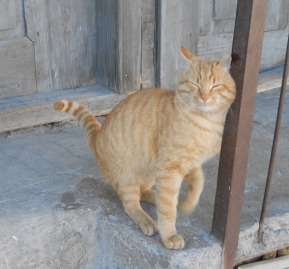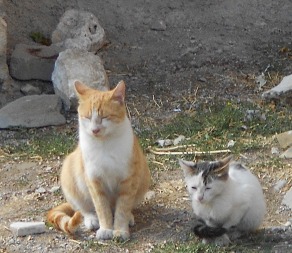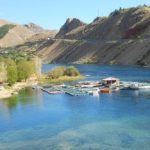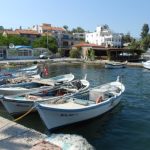Population: 3,000
According to the Nişanyans’ guide to Eastern Turkey Çemişgezek is “the ultimate boondocks”, a place to which no one need ever go. For those who do make the journey to this remote settlement right in the middle of the country it will come as quite a revelation then, not least for its stunning setting on one side of a steep gorge overlooking the Tagar river.
The journey to Çemişgezek is a joy in its own right, especially if you visit from Elazığ when you will need to cross Lake Keban by car ferry. The scenery may not be quite as breath-taking as on the crossing to Pertek but it’s still pretty striking, the barren hillsides above the lake changing in colour as the clouds drift across them. On the way to the lake you’ll see many small vineyards.
Around town
The dolmuş will drop you off in the Meydan, the square in the centre that is, as usual, dominated by a statue of Atatürk.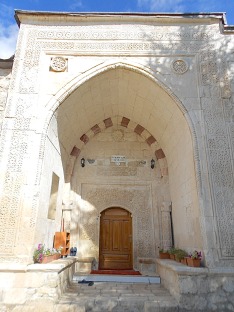
From here you can already sense the glorious surrounding scenery which grows better and better as you strike uphill along Sakarya Caddesi in search of the Yelmaniye Cami. This was erected in 1404 in a style that remains predominantly Selçuk as exemplified by its fine portal and the carving around the windows. The single minaret is a recent addition. You’ll probably find the mosque locked outside of prayer times.
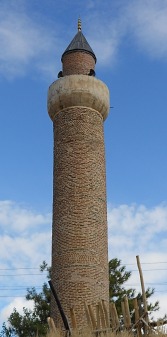 A second mosque, the Süleymaniye, is back behind the Meydan. Although the date of its construction is unknown considered opinion appears to be that it is older than the Yelmaniye although not perhaps as striking. On the other hand it does have a fine brick minaret with a kink in the top rather like the Ulu Cami in Harput.
A second mosque, the Süleymaniye, is back behind the Meydan. Although the date of its construction is unknown considered opinion appears to be that it is older than the Yelmaniye although not perhaps as striking. On the other hand it does have a fine brick minaret with a kink in the top rather like the Ulu Cami in Harput.
By the time you find the Süleymaniye you will be itching to get closer to the great rock that faces the village. Houses are built right against the ridge on the village side but if you follow the road downhill you will come to an opening where you will be able to make out caverns carved out of the rock on the opposite side. These may have formed part of a Cappadocian-style monastery although the sign pointing them out as an attraction identifies them as cells for dervishes.
A small park with picnic benches perches on the edge of the gorge on the village side. Its trees, while lovely, manage to obscure what would otherwise be a fine view down to the river at the foot of the gorge.
If you return to the Meydan and walk back out on the road that brought you into Çemişgezek you’ll see on the left the overgrown ruins of a hamam and on the right what looks to be part of a stone tower that might once have been built into a defensive wall. 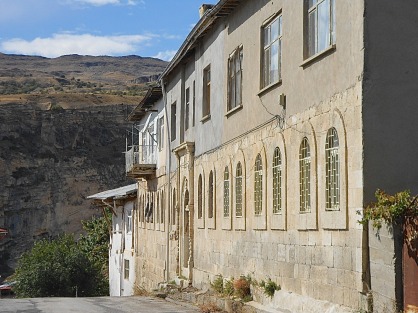 Thanks to Frederike Geerdink for pointing out that this building, which may have started life as a monastery or medrese, later served as a prison in which many Armenian men were detained before being killed in 1915
Thanks to Frederike Geerdink for pointing out that this building, which may have started life as a monastery or medrese, later served as a prison in which many Armenian men were detained before being killed in 1915
Further down the road if you pass the petrol station, enter the park and turn right at the far end along a water channel you will come to a gate in the wall that leads into an enclosure containing a Selçuk-style kumbet (tomb), said to contain the remains of one of two known Uzun Hasans. If the gate is locked turn left beside the wall and at least you’ll be able to glimpse it, buried amid the trees, from afar.
Sleeping
For the time being there’s no hotel in Çemişgezek although there is an Öğretmen Evi if you really want to stay.
Transport info
Minibuses from Elazığ leave to a very limited timetable. To find the ticket office take İzzetpaşa Caddesi beside the big central mosque until you reach the ruined Armenian church, then turn right. You can also pick them up from the Minibus Terminal.
Reserve a place on the minibus back as soon as you arrive to make sure you don’t get stranded.
Hourly ferries leave from the Çemişgezek side on the hour and from the Elazığ side on the half-hour.
There are no bus services from Tunceli to Çemişgezek although you can drive there perfectly easily.
Nearby areas
Very little is written about Çemişgezek. This piece tells a remarkable story: http://kurdishmatters.com/2014/08/06/ravished-armenia-and-ezidi-lands/
